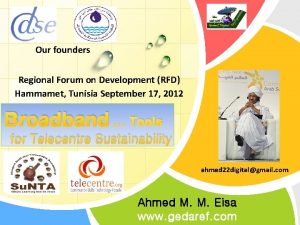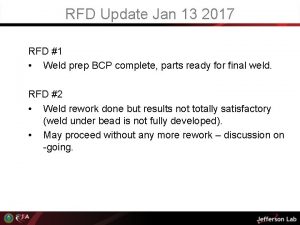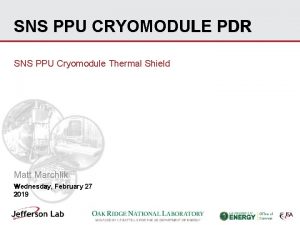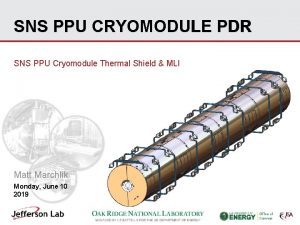RFD Cryomodule Update on structural and thermal calculations







- Slides: 7

RFD Cryomodule Update on structural and thermal calculations Eduardo Cano, Duarte Cartaxo, Joanna Swieszek, CERN, EN-MME logo area UK-CERN Cryomodule meeting – CERN – 14/11/2019

Structural evaluation • Strategy – Full model for global evaluation and submodeling for the detailed study of the supporting systems.

Structural evaluation • Strategy – Full model for global evaluation and submodeling for the detailed study of the supporting systems. • • Full detailed model currently running. Preliminary results: • Maximum deformation > 1 mm on front/back plates. • Maximum stress OK. • Number of top/bottom/lateral stiffeners OK. • Welds of bottom and lateral stiffeners OK (minimum SF ~ 1. 2). • Leak tightness welds OK (minimum SF ~ 2. 5). • Bolts evaluation on top stiffeners Ongoing – High bending moment on lateral bolts • Windows bolts and welds Ongoing

Thermal evaluations 1. He level sensor Material of the level Gauge : G 10 epoxy Sensor diameter: 1/4``, D=6. 35 mm Minimum length for conduction from 2 K to 300 K, L=440 mm Material of the 4 wires : tinned copper (cuivre étamé) Diameter of the inner wire: d=0. 127 mm • • • Heat loss cover sensor TOTAL to 80 K 0. 22 W - 0. 22 W to 2 K 0. 045 W 0. 031 W 0. 08 W External covering parts were simulated in Ansys, sensor including cables were calculated analytically. Heat loss through the wires was added to the total heat loss to the bath (in reality it will go also to the 80 K). Other instrumentation (f. e. temperature sensors) needs to be calculated. Joanna Swieszek, EDMS: 2257528

Thermal evaluations - Joanna 2. Cold-warm transitions • Dynamic heat loss from a constant 1 A current calculated in COMSOL model, dynamic heat loss is very small and can be neglected Heat loss Static dynamic TOTAL CWT x 4 to 80 K 9. 63 W 0 W 38. 52 W to 2 K 1. 34 W 0 W 5. 36 W • • Heat loss to the cold mass is quite big (for DQW cryomodule total heat loss was estimated as 0. 1 W) -> Considering second thermalization? 13 ºC on the bellow flanges, do we need heater there? Joanna Swieszek, EDMS: 2234671

Thermal evaluations - Joanna 3. HOM coaxial lines Ø HHOM Ø VHOM • • • models are being prepared static and dynamic heat loss calculated using COMSOL simplified 2 D axis symmetric model conduction + RF power 1 GHz, 1 k. W coating (5 um of copper on both surfaces? ) materials confirmation Joanna Swieszek, EDMS: 2233186

Thermal evaluations 3. Cryogenic safety device Heat loss for different conditions Liquid He level Boundary conditions Heat loss to 2 K Conduction (no gas) 0. 22 W Gas conduction (analytical) 0. 3 W Conduction (with gas) 0. 48 W Conduction + Radiation 1. 13 W (0. 45 W due to radiation) • Radiation and conduction on He gas contributions are big. • Investigation on the correctness of the radiation calculations is ongoing.













